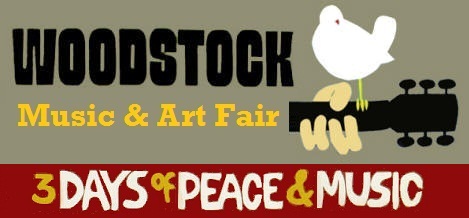

HISTORICITY |
SCHEDULE OF PERFORMERS |
 Richie Havens Richie Havens  |
|
 Sweetwater • Bert Sommer • Tim Hardin • Ravi Shankar Sweetwater • Bert Sommer • Tim Hardin • Ravi Shankar  |
| The next two-plus hours were filled with four performers all of whom are rather obscure in Woodstock annals—two of them are not even listed on the concert's memorial plaque! None would ever achieve notable success in the music entertainment business after their Woodstock appearances. At about 7:30, Sweetwater came on stage. The band had already performed at several big rock concerts and enjoyed mild recognition even though it had no hit single and only one album. According to Sweetwater's contract, the group was supposed to be the opening act because one of the band members recently enlisted in the Air Force reserves (to avoid active duty in Vietnam) and had orders to report for training the very next day in California. Sweetwater represented the lone deviation from folk-rock among the first-day Woodstock acts. Four months after the concert, lead singer Nancy Nevins was involved in an automobile accident hit by a drunken driver, suffered damaged vocal cord that never healed properly. Sweetwater performed briefly without Nevins, awaiting her recovery, but disbanded in 1971. Bert Sommer performed next. Even with the Woodstock appearance—his hour-long set included a standing ovation—Sommer's most memorable link to Counterculture history had already occurred. His frizzy Afro-style hair style was featured on the poster for the 1968 Broadway show Hair. Sommer released three albums after Woodstock. He died in 1990 after a long battle with respiratory illness. Tim Hardin took the stage shortly after 9:00. Talented, but heroin-addicted, his set was a disaster . According to one musician, after a strong start, Hardin announced a song that had not yet been written. The band dutifully improvised as best as possible, but the piece rapidly deteriorated. Hardin died of a drug overdose in 1980 at age 39. Ravi Shankar, a classical sitar player from India, performed for about half an hour until about 10:30, when his set was terminated by rain. He later introduced George Harrison of The Beatles to Eastern music. In 1977, he received India's highest civilian accolade, the Bharat Ratna. He is the father of jazz singer-pianist Norah Jones. |
 Melanie Melanie  |
| Melanie does not appear on the concert poster. That's because she wasn't invited; she invited herself. Several days prior to the concert, 22-year-old Melanie Safka (her age has been reported as low as 15) happened to strike up a conversation with one of the concert promoters. When he mentioned the music festival he was planning, she asked if she could sing there, and the answer was a very laid-back "sure." Safka traveled to Woodstock with her mother, but only Melanie made it aboard the helicopter to the concert itself. Since her attendance was unofficial, she hadn't been issued a performer's pass. Consequently, the stage security initially thought she was just one of the concert goers trying to get on stage. She had to show her driver's license and sing some of her song before they let her pass. The story goes that when she saw the size of the Woodstock crowd she would be playing for—Safka later explained that she thought the event was nothing more than some sort of music festival in the park—she developed a bit of stage fright in the form of a cough that resonated back stage. Someone in the next tent sent her some soothing tea. That kindly neighbor was Joan Baez. Melanie performed only two songs at Woodstock, but she captivated the audience and launched a mildly successful career. Just prior to her performance the festival production coordinator solicited the concert goers to each light a match to reveal the true enormity of the crowd. That incident inspired Melanie's 1970 hit song "Lay Down (Candles in the Rain)." In 1989, she won an Emmy for music in the TV show Beauty and the Beast. |
 Arlo Guthrie • Joan Baez Arlo Guthrie • Joan Baez  |
| The last two performances of Woodstock's first day were Arlo Guthrie, son of legendary folk singer Woody Guthrie, and Joan Baez, the leading female voice of the folk-song movement, who was six months pregnant at the time. Guthrie's identification with the Counterculture came from his 18½ minute Vietnam protest song "Alice's Restaurant Massacre" of two years earlier. He started just prior to midnight and performed three songs. Baez was twice a victim of the concert's first-day confusion. She was initially scheduled to open the concert, but was delayed. Then, Baez apparently played for some 40 minutes at the free stage (the only major performer to do so) set up outside the fence for amateur bands to play for people who did not obtain tickets. before her manager informed her that she was to play on the big stage. Whether or not she actually intended her free stage performance to be is unclear. Her actual concert set included five songs (she played seven on the free stage). She began by telling the crowd of her husband who had been arrested in July by federal marshals for refusing to honor a draft notice. Baez ended Woodstock's first day with "We Shall Overcome," emblematic of the American Civil Rights Movement. Her musical career and activist work have continued since Woodstock. |
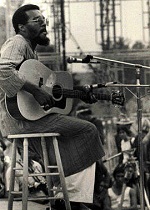 |
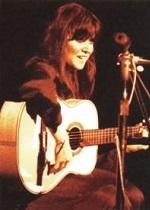 |
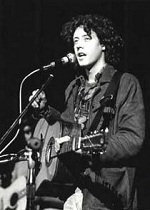 |
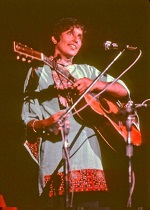 |
|
RICHIE HAVENS |
MELANIE |
ARLO GUTHRIE |
JOAN BAEZ |
 Quill • The Keef Hartley Band Quill • The Keef Hartley Band  |
|
 Country Joe McDonald Country Joe McDonald  |
| With concert officials still scrambling to fill the fractured agenda, Country Joe McDonald agreed to appear after Quill. McDonald was scheduled to play with his band, The Fish, as part of the third day's line-up, so he actually performed twice at Woodstock. He is remembered most for his Saturday acoustic solo set when he orchestrated his now famous "FISH Cheer." Originally the "gimme-an-F" spelled F-I-S-H, but at one concert McDonald spontaneously modified it to spell another four letter word beginning with F and so it was at Woodstock. McDonald's "I-Feel-Like-I'm-Fixin'-To-Die Rag," also a part of his first set, became one of the handful of songs most historically identified with the entire concert. As it turned out, it's also the high point of his musical career. In 1974, he appeared in a Pepsi commercial featuring a Woodstock reunion for yuppies. |
 John Sebastian John Sebastian  |
| John Sebastian, lead singer for the recently disbanded The Lovin' Spoonful, wasn't even under contract to perform at Woodstock, but happened to be milling about the backstage area and, amidst all the confusion, was prevailed upon to do a solo set. He borrowed a guitar from Tim Hardin. Sebastian's career was sputtering, and just a few months before Woodstock he was living in a California commune with hippies who sold bright multi-colored shirts by a process they called "tie-dye" to create bright multi-colored random patterns There are two memorable elements of Sebastian's Woodstock appearance are not musical. His verbal rambling on stage offered several phrases parodically associated with hippies. He was so high on LSD that he forgot the words to one of his songs and asked the audience for help. His name is misspelled ("Sabastian") on the Woodstock memorial plaque. He would later compose the theme music for a 1976 TV sitcom entitled Welcome Back, Kotter, which reached #1 on the charts. The Lovin' Spoonful was inducted into the Rock and Roll Hall of Fame in 2000. More recently, Sebastian has co-hosted a half-hour televison program called The Golden Age of Rock and Roll, which was essentially a lengthy commercial for a 1960s and 1970s era rock CD compilation. His dialogue was much more discernible than his Woodstock. After playing a portion of "I Had A Dream," he stops singing and implores the crowd to "everybody sing—help me out!" Such crowd participation is common at rock concerts, so it seems that Sebastian is simply following suit. But in truth, he forgot the words to his own song! |
 Santana Santana  |
| Some sources consider Santana, came on stage at about 5:15, the real beginning of day two. Santana's performance at Woodstock is one of the concert's sensations. No album; no following. Kicked off a spectacular career. Under the assumption that the band's turn on stage was still several hours away, Carlos Santana took mescaline. "I thought, 'If I take it now, by the time I come to play I'll be coming down and life is beautiful," you know? Wrong!" They were shoved on stage The live Woodstock version lengthy "Soul Sacrifice" has appeared on several Santana albums/CDs over the years. Santana has flourished since Woodstock with a variety of personnel (original organist Gregg Rolie left to form the band Journey). Guitarist/singer Carlos Santana strategically extended his popularity into the next century, recording albums and registering hits with musicians more popular with the younger audience, such as Dave Matthews, Rob Thomas of Matchbox Twenty, Michelle Branch, and Chad Kroeger of Nickelback. The strategy has enabled Santana to widen his fan base while maintaining his Santana's "Supernatural" won the 2000 Grammy Award for Best Rock Album of the Year. |
 Incredible String Band • Canned Heat • Mountain Incredible String Band • Canned Heat • Mountain  |
| Canned Heat and Mountain were the next two performers, but the order in which the bands appeared is sometimes reversed. band played before the other Canned Heat broke up in 1976. Guitarist Al "Blind Owl" Wilson died of a drug overdose in 1970. In 1981, vocalist Bob "The Bear" Hite died from a drug-related heart attack. Mountain split in 1972. Bass player Felix Pappalardi was shot and killed by his wife in 1983. Guitarist Leslie West released a solo album in 1988. According to most sources, the next performance was a Scottish group called The Incredible String Band, known for Raga Rock, a combination of Indian music and rock 'n' roll. The band was originally slated for Thursday night, but refused to perform once the rain started. The group disbanded in 1973. One of the band members, female bassist Rose Simpson, would later become the mayor of a town in Wales. Starting around 8:00, |
 Grateful Dead Grateful Dead  |
| The Grateful Dead remained popular for years as a cult band without numerous Top Forty hits. The more recent equivelent of The Grateful Dead is Phish, although not nearly so musically talented as The Dead. Keyboardist Ron "Pigpen" McKernan died of a liver ailment in 1973.Grateful Dead's performance was plagued by technical problems, including a faulty electrical ground and members Jerry Garcia and Bob Weir reported getting shocked every time they touched their guitars. |
 Creedence Clearwater Revival Creedence Clearwater Revival  |
| The timing of Woodstock couldn't have been better for Creedence Clearwater Revival. The band was in the midst of a short-lived existence, just far enough along in its hit parade to make it a huge audience attraction, and at the same time create additional momentum for future hits (10 Top Ten songs between 1968 and 1971). Its song list would make a pretty good "greatest hits, volume one" collection. CCR, wrought with internal bickering, disbanded in 1972. Rhythm guitarist and singer Tom Fogerty (he actually left the band prior to its demise) pursued a solo career that never really went anywhere. His one bona fide hit, "Joyful Resurrection," sounds remarkably like Creedence material. In fact, his three Creedence bandmates all perform the song, although some of the parts were dubbed in. He died in 1990 at age 48 from AIDS (specifically from a tuberculosis infection), having contracted HIV from blood transfusions for back ailments. Drummer Doug "Cosmo" Clifford and bassist Stu Cook, after some individual musical endeavors, formed a band called Creedence Clearwater Revisited which plays all of the CCR hits. The band is difficult to listen to for real CCR aficionados—imagine listening to The Beatles without Paul McCartney or The Rolling Stones without Mick Jaggar. The overwhelming talent behind CCR's success, lead singer and guitarist, John Fogerty, went on from his Creedence days to a successful solo career. His 1984 song "Centerfield" is still played often enough as a rock 'n' roll baseball anthem (iin 2010 the song became an official entry in the Cooperstown Hall of Fame) . For years, he refused to play any of the Creedence songs, almost all of which he wrote, citing bitterness and bad memories of the break-up, including publishing disputes with the band's record label company, Fantasy. In 1987, he relinquished, to the pleasure of CCR fans, when he performed in Washington, D.C. for Vietnam veterans. The animosity between Fogerty and the others has never eased. He was still estranged from his brother When he died. When CCR was inducted into the Rock and Roll Hall of Fame in 1993, Fogerty publically displayed his animosity with his former band mates by refusing to play with them. Fogerty's "Blue Moon Swamp" won the 1997 Grammy Award for Best Rock Album of the Year. He released "Revival" in 2008. |
 Janis Joplin Janis Joplin  |
| Text here. |
 Sly & The Family Stone Sly & The Family Stone  |
| Text here. |
 The Who The Who  |
| Text here. |
 Jefferson Airplane Jefferson Airplane  |
| Text here. |
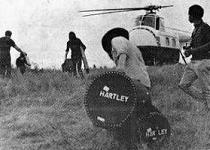 |
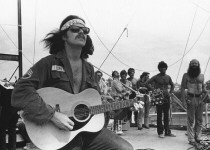 |
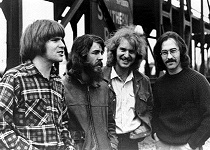 |
|
HELICOPTER AWAITS BAND MEMBERS |
COUNTRY JOE MCDONALD |
CREEDENCE CLEARWATER REVIVAL |
 Joe Cocker Joe Cocker  |
|
 Country Joe & The Fish Country Joe & The Fish  |
| Text here. |
 Ten Years After Ten Years After  |
| Text here. |
 The Band The Band  |
| Text here. |
 Blood, Sweat & Tears Blood, Sweat & Tears  |
| Text here. |
 Johnny Winter Johnny Winter  |
| Text here. |
 Crosby, Stills, Nash & Young Crosby, Stills, Nash & Young  |
| Text here. |
 Paul Butterfield Blues Band Paul Butterfield Blues Band  |
| Text here. |
 Sha Na Na Sha Na Na  |
| Text here. |
 Jimi Hendrix Jimi Hendrix  |
| Text here. |
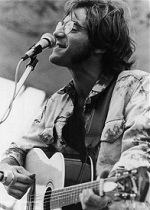 |
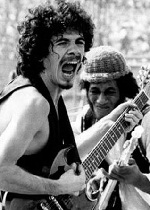 |
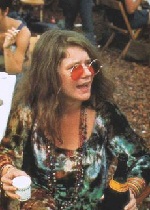 |
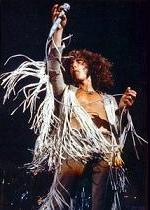 |
|
JOHN SEBASTIAN |
SANTANA |
JANIS JOPLIN |
ROGER DALTREY |
 COULDA, WOULDA, SHOULDA COULDA, WOULDA, SHOULDA  |
| Several performers narrowly missed, for various reasons, being part of history's greatest rock concert. Perhaps the most famous near-miss was Joni Mitchell. She cancelled the day prior because she feared getting stuck in traffic and missing her scheduled prime time television appearance on The Dick Cavett Show. She was actually travelling to Bethel with some other musicians when she had the last-minute change of heart (reportedly stirred by her manager). Still, Mitchell is an everlasting part of the Woodstock legacy. She composed the song that became the concert's anthem—simply entitled "Woodstock"—when it was recorded by Crosby, Stills, Nash & Young in 1970. Canadian group Lighthouse renegged on an agreement to play at Woodstock fearing that it might turn into a bad scene and create negative publicity ultimately harmful to the group's chance for success. The band's biggest hit, "One Fine Morning," peaked at #24 in 1971. Ethan Brown, a solo guitarist popular among the hippies, missed his chance because he was arrested on drug charges three days before the concert. Interestingly, whereas Joni Mitchell, Lighthouse, and Ethan Brown reportedly signed to play at Woodstock, it's next to impossible to find them listed on concert posters and programs printed weeks ahead of the concert. Conversely, some print lists Nick Benes and Jack Harrison (who?) as performers. The Jeff Beck Group (with lead singer Rod Stewart) and The Moody Blues were both listed among the day three performers on early Woodstock posters and handbills. The former dissolved a week before the concert; the latter, as it turned out, was already booked in Paris on the Woodstock dates. Iron Butterfly—fondly remembered for their one and only hit "In-A-Gadda-Da-Vida"—became stranded at the airport because of the traffic jam. The group's manager, ignoring pleas for patience amid the existing chaos, insisted on immediate transportation and special treatment once the band arrived at the actual event site. Concert officals informed the obstinate manager that his requests would be processed and he would be called back soon with details. In truth, the demands were hardly given a second thought. The decision was made, under the circumstances, to simply make do without Iron Butterfly. The next communication to the band was a graphic equivalent of "get lost." There are two explanations commonly offered for the absence of The Doors. One account claims the band was not extended an invitation because of the wild X-rated antics of lead singer Jim Morrison. The more credible story is that Morrison's increasing paranoia, bolstered by a recent drug bust, convinced him that outdoor venues should be avoided because he was a prime target for assassination. (There's actually a term for such a fear—"agoraphobia.") |
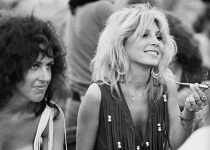 |
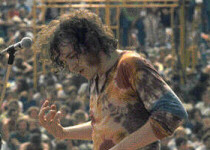 |
 |
|
GRACE SLICK AND FRIEND |
JOE COCKER |
CROSBY, STILLS & NASH |
 THANKS, BUT NO THANKS THANKS, BUT NO THANKS  |
| The list of notable performers who blew opportunities to play at Woodstock grows. Some alleged refusals are based on hearsay; others are more verifiable. The most notorius snub came from Bob Dylan. Concert organizers and attendees alike assumed that Dylan would appear since he lived just a 90-minute drive from Bethel (in the concert's namesake town). In fact, he wanted nothing to do with it. "Woodstock—I didn't want any part of that thing....That didn't excite me....I wasn't into that at all. I just thought it was a lot of kids out and around wearing flowers in their hair, takin' a lot of acid. I mean, what can you think about that?" Instead, he signed to play at a concert in England later in the month and on Woodstock's opening day was boarding an ocean liner to travel across the Atlantic. Led Zeppelin were asked to perform, but decided to play somewhere else because the pay was higher and their manager reasoned that, given the sizable Woodstock agenda, Led Zeppelin would "have just been another band on the bill." John Lennon was contacted regarding the possibility of reviving The Beatles (the "Fab Four" hadn't done a concert since 1966). Lennon replied that whereas The Beatles would be unavailable, his wife's Plastic Ono Band would be willing to perform. Nothing materialized because Lennon was denied entrance into the United States by Nixon immigration officials owing to drug arrest charges the previous year. Some sources cite disinterest in Yoko Lennon's band as a significant contributing factor. Interestingly, the absence of The Beatles, as well as The Rolling Stones (it's unclear whether The Stones were ever actually contacted about taking part), was not overly upsetting to Woodstock organizers. According to one concert official, the two rock 'n' roll giants would have "overpowered" the festival line-up: "Woodstock was not intended to be about any one band...." (Sour grapes?) Indeed, this was reflected in the contract arrangement with Jimi Hendrix. Hendrix had initially insisted on headline billing, common in the music concert business. The headliner format meant that the performer would be first and foremost on all radio and print ads, as well as the event's finale. However, the Woodstock organizers had decided all artists would be treated uniformly—listed alphabetically and with the same typeface on posters (obviously, Hendrix acquiesced). The Byrds turned Woodstock down because the group had fresh in their minds was a melee at a July concert in Atlanta. British group Procol Harum were invited but refused because Woodstock fell at the end of a long tour and, as well, coincided with the due date of guitarist and expectant father Robin Trower (as it turned out, the birth was two weeks late). Jethro Tull declined an invitation. The reason is obscure, but the story offered most is that lead singer and flutist Ian Anderson didn't think the event would amount to much more than a "...weekend in a field of unwashed hippies." Johnny Cash, prior to achieving his status as a country music legend, and Donovan, a British singer-songwriter and guitar player with a unique sound, both declined for unspecified reasons. The popular folk rock duo Simon & Garfunkel apparently weren't interested in doing any more appearances for a time, tired of being together after a busy spring concert schedule. Other performers reported to have rejected offers include Free, an English band best known for its massive hit "All Right Now," Eric Clapton, the only three-time inductee to the Rock and Roll Hall of Fame (as a member of The Yardbirds and Cream as well as solo efforts) Paul Revere and the Raiders, The Mothers of Invention, Tommy James and the Shondells, Mind Garage, a Christian psychedelic rock band from West Virginia before the genre of Christian rock was common, and Spirit, a relatively unknown group out of California. One of the concert promotors "had his heart set" on enlisting actor and country crooner Roy Rogers to finish the concert with his theme song "Happy Trails to You." Years later, Rogers revealed his simple reason for refusing the offer: "I would've been booed off the stage by all those goddamn hippies." |
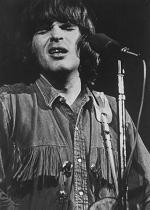 |
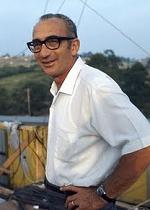 |
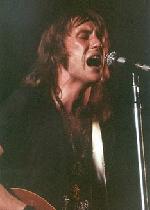 |
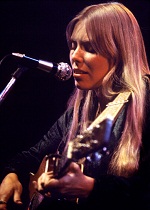 |
|
JOHN FOGERTY |
MAX YASGUR |
ALVIN LEE |
JONI MITCHELL |
 THE MOVIE THE MOVIE  |
| Less than a year after the concert, Warner Bros. released the movie Woodstock, a documentary presentation of the entire Woodstock festival experience, showing not only the music of Woodstock, but ample footage of concert management, hippies in attendance, and local community reaction. As a whole, the musical portion of the movie is somewhat disappointing. Several key performers are not featured, owing to technical problems, director's decision, and issues originating with some performers themselves—Keef Hartley's manager refused to have the band filmed in the first place; John Fogerty, unhappy with CCR's performance, balked at granting permission for Creedence to be included; Neil Young did not want himself filmed when he was when he was on stage with Crosby, Stills & Nash. As for the acts which do appear in the movie, some were not shown performing one of their signature "best of" selections (which, let's be honest, most of us prefer if we're limited to just one song per performer). Still, some meaningful historical moments are captured—Joan Baez's account of her husband's arrest for failing to report for duty after being drafted, John Sebastian's hippie-esque verbal ramble on stage, Country Joe McDonald's "FISH Cheer," and the rain interruption of the concert's third day, among others. The movie's performance highlights are Richie Havens ("Freedom"), Joe Cocker ("With a Little Help from My Friends"), Crosby, Stills & Nash ("Suite: Judy Blue Eyes"), Ten Years After ("I'm Going Home"), Santana ("Soul Sacrifice"), and Jimi Hendrix ("The Star-Spangled Banner"). Woodstock was a box-office hit. By 1999, the film had grossed over $100 million. The soundtrack album, on the Atlantic label, was similarly successful. In 1994, the "Director's Cut" (subtitled 3 Days of Peace & Music) was released that added over 40 minutes to the already lengthy film. Performances by Canned Heat, Jefferson Airplane, and Janis Joplin, all absent from the original movie, were included. Additionally, Jimi Hendrix's set at the end of the film was extended by two additional songs. Some of the crowd scenes in the 1970 film were replaced by previously unseen segments. Two expanded versions were released in 2009. A remastered "40th Anniversary Edition" was issued both as "Special Edition" (two discs) and "Ultimate Collector’s Edition" (three discs) available in Blu-ray and DVD formats. Included are two extra hours of concert footage, comprised of 18 never-before-seen performances from 13 acts, namely Joan Baez, Country Joe McDonald, Santana, The Who, Jefferson Airplane, Canned Heat, and Joe Cocker plus five—Paul Butterfield Blues Band, Creedence Clearwater Revival, The Grateful Dead, Mountain, and Johnny Winter—which played at Woodstock but never appeared in any film version. Since 1996, Woodstock: 3 Days of Peace and Music is officially preserved in the United States National Film Registry, designated by the Library of Congress as being "culturally, historically, or aesthetically" significant. All of the various Woodstock movies are rated R for nudity, profanity, and frequent display of drug use. |
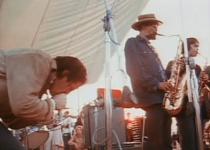 |
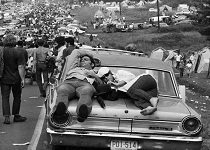 |
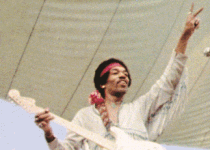 |
|
PAUL BUTTERFIELD BLUES BAND |
TRAFFIC JAM ON ROUTE 17B |
JIMI HENDRIX |
EXCURSION SOUNDTRACK |
RICHIE HAVENS |
JANIS JOPLIN |
COUNTRY JOE & THE FISH |
QUESTIONS |
|
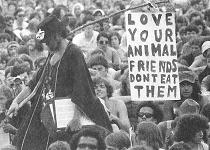 |
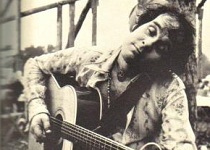 |
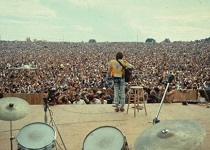 |
|
CONCERT ANIMAL RIGHTS ACTIVISM |
TIM HARDIN |
CROWD VIEW FROM THE STAGE |
EXTENDED RESPONSE |
|
Well, I came upon a child of God; He was walking along the road, And I asked him, where are you going? This he told me: Said I'm going on down to Yasgur's farm, Going to join in a rock and roll band; Got to get back to the land and set my soul free. We are stardust, we are golden, We are billion-year-old carbon; And we've got to get ourselves Back to the garden. |
Well, then can I walk beside you? I have come to lose the smog, And I feel like I'm a cog in something turning. And maybe it's the time of year, Yes, and maybe it's the time of man; And I don't know who I am but life is for learning. We are stardust, we are golden, We are billion-year-old carbon; And we've got to get ourselves Back to the garden. |
By the time we got to Woodstock We were half a million strong, And everywhere was a song and a celebration. And I dreamed I saw the bomber death planes Riding shotgun in the sky, Turning into butterflies above our nation. We are stardust, we are golden, We are caught in the devil's bargain; And we've got to get ourselves Back to the garden. |
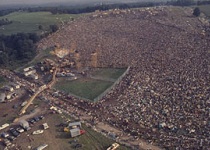 |
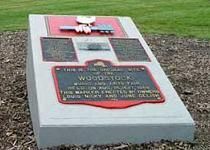 |
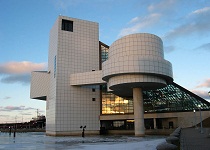 |
|
CONCERT AERIAL SCENE |
WOODSTOCK MEMORIAL PLAQUE |
ROCK AND ROLL HALL OF FAME |
"Every gun made, every warship launched, every rocket fired signifies...theft from those who hunger and are not fed, those who are cold and not clothed." —Dwight D. Eisenhower |